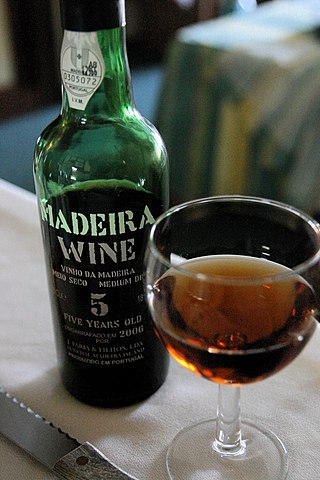
Madeira is a fortified wine made on the Portuguese island of Madeira, in the North Atlantic Ocean. Madeira is produced in a variety of styles ranging from dry wines which can be consumed on their own, as an apéritif, to sweet wines usually consumed with dessert. Cheaper cooking versions are often flavoured with salt and pepper for use in cooking, but these are not fit for consumption as a beverage.

Malvasia, also known as Malvazia, is a group of wine grape varieties grown historically in the Mediterranean region, Balearic Islands, Canary Islands and the island of Madeira, but now grown in many of the winemaking regions of the world. In the past, the names Malvasia, Malvazia, and Malmsey have been used interchangeably for Malvasia-based wines; however, in modern oenology, "Malmsey" is now used almost exclusively for a sweet variety of Madeira wine made from the Malvasia grape. Grape varieties in this family include Malvasia bianca, Malvasia di Schierano, Malvasia negra, Malvasia nera, Malvasia nera di Brindisi, Malvasia di Candia aromatica, Malvasia odorosissima, and a number of other varieties.

Seyval blanc is a hybrid wine grape variety used to make white wines. Its vines ripen early, are productive and are suited to fairly cool climates. Seyval blanc is grown mainly in England, the United States East Coast, in the Pacific Northwest (Oregon), as well as to a lesser extent in Canada. Seyval blanc was created either by Bertille Seyve, or his son-in-law Villard, as a cross of Seibel 5656 and Rayon d'Or, and was used to create the hybrid grape St. Pepin. Seyve and Villard used the same Rayon d'Or x Seibel 5656 crossing to produce the red wine grape Seyval noir.
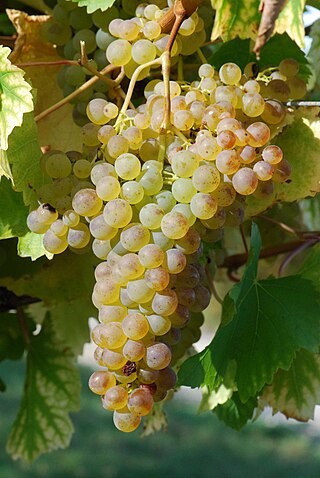
Colombard is a white French wine grape variety that may be the offspring of Chenin blanc and Gouais blanc. This makes the grape the sibling of the Armagnac Meslier-Saint-François and the nearly extinct Cognac grape Balzac blanc.
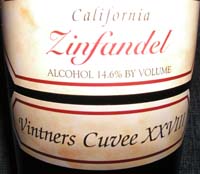
A varietal wine is a wine made primarily from a single named grape variety, and which typically displays the name of that variety on the wine label. Examples of grape varieties commonly used in varietal wines are Cabernet Sauvignon, Chardonnay and Merlot. Wines that display the name of two or more varieties on their label, such as a Chardonnay-Viognier, are blends and not varietal wines. The term is frequently misused in place of vine variety; the term variety refers to the vine or grape, while varietal refers to the wine produced by a variety.

Trousseau or Trousseau Noir, also known as Bastardo and Merenzao, is an old variety of red wine grape originating in eastern France. It is grown in small amounts in many parts of Western Europe; the largest plantations are today found in Portugal, where most famously it is used in port wine. It makes deep cherry red wines with high alcohol and high, sour candy acidity, and flavours of red berry fruits, often complemented - depending on production - by a jerky nose and an organic, mossy minerality.
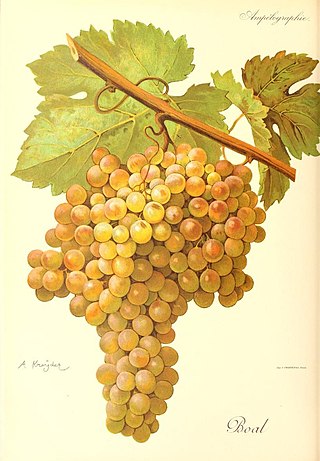
Boal is a name given to several varieties of grape cultivated in Portugal, notably in the production of medium-rich fortified wines from Madeira Island. On many wine labels of Madeira wine, the variety's name is anglicized as Bual. Bual from Madeira is typically less sweet than that from Malmsey, but more sweet than Sercial or Verdelho. The vines are also common in Portugal and Spain, where the fruit is used in the same way for fortified wines.

Aligoté is a white grape used to make dry white wines, especially in the Burgundy region of France where it was first recorded in the 18th century. Since it is tolerant to cold, this variety is also cultivated in Eastern European countries. In 2004, it was the 22nd most planted vine variety in the world at 45,000 hectares.
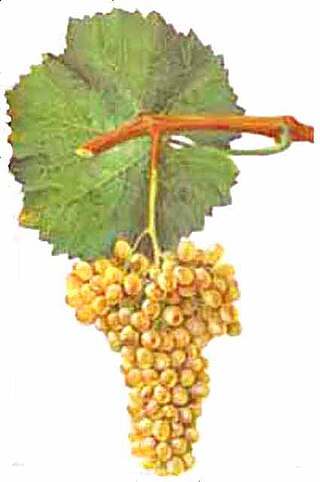
Verdelho is a white wine grape grown throughout Portugal, though most associated with the island of Madeira, and also gives its name to one of the four main types of Madeira wine. At the turn of the 20th century it was the most widely planted white grape in Madeira.

Portuguese wine was mostly introduced by the Romans and other ancient Mediterranean peoples who traded with local coastal populations, mainly in the South. In pre-Roman Gallaecia-Lusitania times, the native peoples only drank beer and were unfamiliar with wine production. Portugal started to export its wines to Rome during the Roman Empire. Modern exports developed with trade to England after the Methuen Treaty in 1703. From this commerce a wide variety of wines started to be grown in Portugal. In 1758, one of the first wine-producing regions of the world, the Região Demarcada do Douro was created under the orientation of Marquis of Pombal, in the Douro Valley. Portugal has two wine-producing regions protected by UNESCO as World Heritage: the Douro Valley Wine Region and Pico Island Wine Region. Portugal has a big variety of local kinds, producing a very wide variety of different wines with distinctive personality.

Nero d'Avola is "the most important red wine grape in Sicily" and is one of Italy's most important indigenous varieties. It is named after Avola in the far south of Sicily, and its wines are compared to New World Shirazes, with sweet tannins and plum or peppery flavours. It also contributes to Marsala Rubino blends.
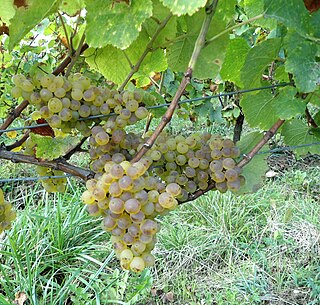
Savagnin or Savagnin blanc is a variety of white wine grape with green-skinned berries. It is mostly grown in the Jura region of France, where it is made into Savagnin wine or the famous vin jaune and vin de paille.

Cuvée is a French wine term that derives from cuve, meaning vat or tank. Wine makers use the term cuvée with several meanings, more or less based on the concept of a tank of wine put to some purpose.
The classification of wine is based on various criteria including place of origin or appellation, vinification method and style, sweetness and vintage, and the grape variety or varieties used. Practices vary in different countries and regions of origin, and many practices have varied over time. Some classifications enjoy official protection by being part of the wine law in their country of origin, while others have been created by, for example, growers' organizations without such protection.

The Isabella grape is a cultivar derived from the grape species Vitis labrusca or 'fox grape,' which is used for table, juice and wine production.
Mouton Cadet is the brand name of a popular range of modestly priced, generic Bordeaux wines, considered Bordeaux's most successful brand. Created by Baron Philippe de Rothschild, Mouton Cadet wine is produced through the assembly of a variety of grapes, from several Bordeaux region appellations.
Gattinara is a red Italian wine with denominazione di origine controllata e garantita (DOCG) status produced from Nebbiolo grapes grown within the boundaries of the comune of Gattinara, which is located in the hills in the north of the province of Vercelli, northwest of Novara, in the Piedmont region. It was awarded DOC status in 1967 and received its DOCG classification in 1990.

Mas de Daumas Gassac is a French wine producer from the wine region Languedoc, classified as Vin de Pays de l'Hérault due to its use of grape varieties outside specifications of its AOC. The winery, producing both white and red wine, is located in the south of France, in the commune of Aniane. Despite its modest designation and location, the vineyard has received widespread acknowledgement, described by The Times to taste like a "Latour" and by the French gastronomic guide GaultMillau as the "Lafite Rothschild of the Languedoc-Roussillon", it is frequently referred to as the Grand cru of the Languedoc.

Bucelas is a Portuguese wine-region located in the Lisboa wine-region. The region has Portugal's highest wine classification as a Denominação de Origem Controlada (DOC). Located south of the Arruda DOC, the region is noted for its potential for cool fermentation white wine production. Vineyards in the area are planted on predominantly loam soils. The white wines of Bucelas became widely popular during the Elizabethan era in England and again during the Victorian age. In London the wines were sometimes described as Portuguese hock because of their similarities to the German Rieslings from the Rhine. Urban sprawl in the 20th century has drastically reduced viticulture in the area, located north of the Portuguese capital city, Lisbon.
Terrantez is a now-rare white Portuguese wine grape variety that was once widely used on the island of Madeira to make the sweet fortified wine for which the island is known. By the 1990s, the variety was nearly extinct on Madeira, due to a combination of low yields and the mid-19th century oidium and phylloxera epidemics that devastated the island's vineyards. The variety has experienced a slow revival in recent years, but as of 2021, plantings on Madeira remain limited to 5.64 hectares. The Madeiran government has led replanting efforts from 2016 in the form of free viticultural advice and subsidies to growers. There are still some limited plantings in the Minho Province where, as Cascal, is a permitted blending variety with Alvarinho and other grapes in the Denominação de Origem Controlada (DOC) wine Vinho Verde. As Terrantez the grape is permitted in several of the Indicação de Proveniencia Regulamentada (IPR) regions of the Azores including Biscoitos IPR on Terceira Island, Graciosa IPR on the island of Graciosa and Pico IPR on Pico Island.
















